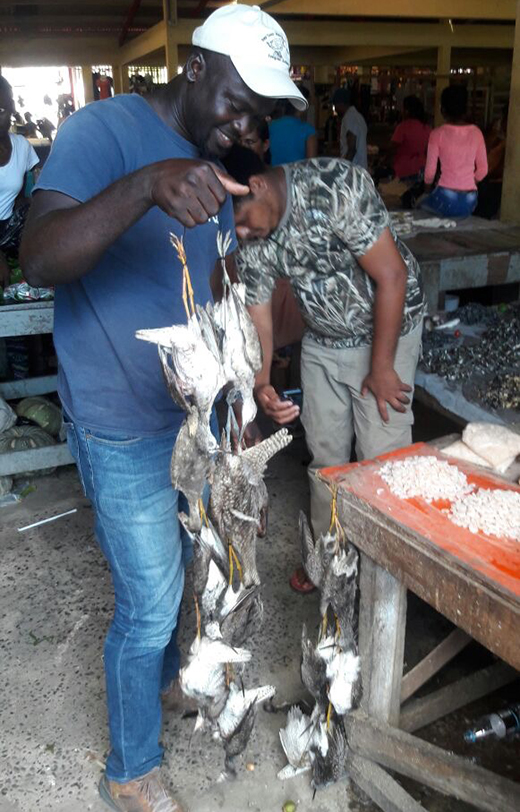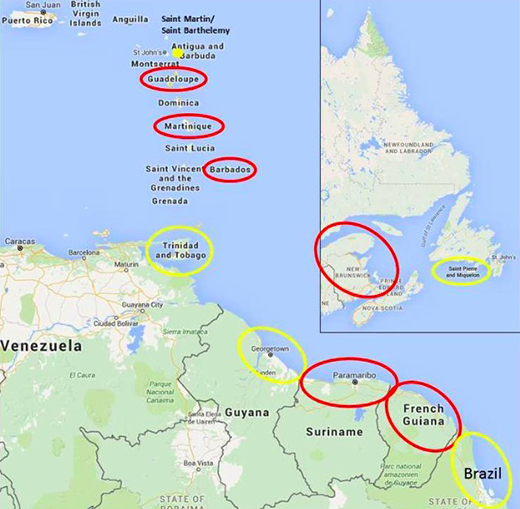
Leon Moore with yellowlegs being sold in a market in Guyana. Photo courtesy of Leon Moore.
Many species of shorebirds in the Americas migrate through the Caribbean, and unsustainable hunting practices in this region pose a risk to these species’ long-term survival. Lesser Yellowlegs are hunted at high levels across the Caribbean and northern South America, but species such as Whimbrel and Semipalmated Sandpiper are also affected. These hunting practices include hunting for subsistence, commercial selling in local markets, sport, cultural tradition, and lethal removal from agriculture operations. In some locations this hunting is legal, and in others it occurs illegally.
In 2011 international attention was drawn to this issue after two satellite-tagged Whimbrels name Machi and Goshen survived a hurricane only to be shot upon landfall in Guadeloupe. Bird conservation groups then began to examine the sustainability of these practices in countries across the Caribbean and northeastern South America. Rather than seeking to end hunting entirely, these efforts – led by the Atlantic Flyway Shorebird Initiative Harvest Working Group – have focused on ensuring that shorebird hunting is sustainable for species’ survival within the cultural contexts of the different countries. By working to understand and shape existing cultural practices, instead of outlawing them, conservation organizations hope to develop win-win outcomes for both shorebirds and local communities.
An online survey of members of Birds Caribbean was conducted in 2011 to identify focal areas for reducing hunting (see Figure below). Since then, social assessments of hunting practices have been conducted, in conjunction with biological assessments, guided by an action plan developed by the Atlantic Flyway Shorebird Initiative Harvest Working Group. Social assessments and biological assessments will be used together to target priority areas where hunting may be most impacting bird populations. Hunter assessments have been completed in Suriname and French Guiana in South America, and in Barbados in the Caribbean.
Research methods vary between sites. In the Barbados study, data on number of shorebirds harvested were gathered from shorebird hunting club logbooks. In the Suriname study, a questionnaire was developed that included questions asking hunters why they hunted (e.g., recreation, need-based), how they hunted (e.g., gun, nets), the number of hunting trips made and how that has changed over the last 10 years, as well as demographic information (e.g., age, family status, economic status). Hunters were also asked how much hunting takes place in the areas where they hunted. Participants were selected randomly from official government lists of licensed hunters. Following the methods developed for Suriname, researchers in French Guiana gathered data using a questionnaire with two parts: one asking questions about the respondent’s hunting effort and hopes over the previous five years, and one that assessed the magnitude and results of their hunting on the day they were being surveyed. Surveys were administered opportunistically over two years to hunters actively hunting shorebirds in rice fields. Country-specific research insights and outcomes are summarized below.
Research Insights
- In the study in Suriname, two thirds of respondents reporting hunting primarily for subsistence. Hunters also reported hunting less now than 10 years ago due to perceived increase in law enforcement, decrease in shorebird population, and increased physical limitations from an aging hunting population.
- In the study of hunters in French Guiana, the majority of hunters reported hunting for subsistence or to sell, and only 3% reported hunting for sport. Most respondents were from the local area, and were opportunistic about what taxa of shorebird they hunted – hunting whatever species were available.
- In the study of hunting club logbooks in Barbados, results suggested that hunting levels are close to exceeding sustainable mortality rates in some years for species such as Lesser Yellowlegs.

Initial (red) and secondary (yellow) focal areas to address the sustainability of shorebird harvest in the Western Atlantic Flyway, identified through a survey of members of Birds Caribbean. Excerpted from Achieving a Sustainable Shorebird Harvest in the Caribbean and Northern South America – Progress Report, 2011-2017 (unpublished).
Outcomes
- Results from Suriname have been used to guide more targeted patrols by Suriname Forest Service/Nature Conservation Division rangers in and around protected areas, where there are high levels of both hunting and shorebirds. A hunter education program is being developed in Suriname to reduce illegal hunting.
- Results from French Guiana have been used to support policy changes. These changes include legal protections for species such as Red Knot, and the recent creation of a national hunting license scheme. Granting of licenses will provide additional data on where people are hunting, and to obtain a license hunters will have to participate in short an educational program explaining which shorebird species are illegal to hunt.
- The Canadian Wildlife Service worked directly with the Barbados Wildfowlers Association and shorebird hunting clubs to help them develop and implement a set of voluntary harvest restrictions.
Together, this project shows how site-specific human dimensions research studies can contribute to international conservation efforts. More human dimensions research is ongoing or about to begin in Guyana, Brazil, and Trinidad and these upcoming projects are expected to inform improvements to outreach, enforcement, and policy efforts. Harvest levels are being monitored on Barbados and the French island of Guadeloupe.
To learn more about this study or gain access to literature related to this project, contact Brad Andres: brad_andres@fws.gov.

